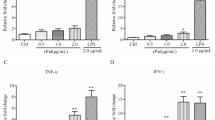Abstract
Salmonella enterica serovar Typhimurium and its surface components were assessed for their inflammatory potential by footpad oedema test using plethysmometer. Inflammation was found to be the highest when outer membrane proteins (OMPs) were used as inflammagen followed by lipid associated protein-lipopolysaccharide complex (LAP-LPS) and lipopolysaccharides (LPS). Inflammation produced by OMPs was found to be comparable to that by carrageenan (a known positive inflammagen). However, injection of L-histidine (an antioxidant) prior to administration of carrageenan or Salmonella enterica serovar Typhimurium inhibited the inflammation, which indicated the involvement of oxidants during inflammatory response. Nicotinamide adenine dinucleotide phosphate (NADPH) oxidase and nitric oxide (NO) production by peritoneal macrophages from infected mice exhibited a significant increase as compared to those of the immunized mice. In contrast, glutathione production was found to be the maximum in the macrophages taken from OMPs-immunized mice followed by LAP-LPS and LPS alone. The biochemical studies correlated well with histopathological studies of intestinal tissue of animals from various groups. Based upon these parameters, inflammation seems to be modulated by OMPs and LAP-LPS, which may be because of the protein moieties present in the components. Hence, immunization with protein moieties having L-histidine or L-histidine-like structures may suggest an alternative to the potential therapeutic values of anti-inflammatory drugs. Thus the results of this study form the basis for evaluating these antigens (either alone or in combination with polysaccharides) for preventive intervention rather than therapeutic. (Mol Cell Biochem 270: 167–175, 2005)
Similar content being viewed by others
References
Giannella RA: Importance of the intestinal inflammatory reaction in Salmonella mediated intestinal secretion. Infect Immun 23: 140–145, 1979
Henson PM, Johnston RB: Tissue injury in inflammation: Oxidants, proteinases and cationic proteins. J Clin Invest 79: 669–674, 1987
Ballmer PE, Reinhart WH, Gey KF: Antioxidant vitamins and disease risk of suboptimal supply. Ther Umsch 51: 467–474, 1994
DeGroote MA, Fang FC: Antimicrobial properties of nitric oxide. In F.C. Fang (ed). Niric Oxide and Infection. Kluwer Academic/Plenum, New York, NY, 2000, pp 231–261
James SL: Role of nitric oxide in parasite infections. Microbiol Rev 59: 533–547, 1995
Nathan C, Shiloh MU: Reactive oxygen and nitrogen intermediates in the relationship between mammalian hosts and microbial pathogens. Proc Natl Acad Sci USA 97: 8841–8848, 2000
Miesel R, Zuber M: Copper-dependent antioxidase defenses in inflammatory and autoimmune rheumatic diseases. Inflammation 17: 283–294, 1993
Stenson WF: Role of eicosanoids as mediators of inflammation in inflammatory bowel disease. Scand J Gastroenterol Suppl 72: 13–18, 1990
Klimpel GR, Asuncion M, Haithcoat J, Niesel DW: Cholera toxin and Salmonella typhimurium induce different cytokine profiles in the gastrointestinal tract. Infect Immun 63: 1134–1139, 1995
Windrow VR, Winyard PG, Morris CJ, Blake DR: Free radicals in inflammation: Second messengers and mediators of tissue destruction. Br Med Bull 49: 506–522, 1993
Floreani M, Petrone M, Debetto P, Palatini P: A comparison between different methods for determination of reduced and oxidized glutathione in mammalian tissues. Free Radic Res 26: 449–445, 1997
Koul A, Singh A, Sandhir R: Effect of α-tocopherol on the cardiac antioxidant defense system and atherogenic lipids in cigarette smoke-inhaling mice. Inhal Toxicol 15: 513–522, 2003
Galdiero F, Antonietta M, Marilena G, Masiello S, Rosa M: Inflammatory effect of Salmonella typhimurium porins. Infect Immun 58: 3183–3186, 1990
Galdiero F, Cipollario G, Benedetto LN, Galdiero M: Release of cytokines induced by Salmonella typhimurium porins. Infect Immun 61: 155–161, 1993
Rishi P, Ganguly NK, Sharma BK, Sharma S, Sehgal R: Specific immunoglobulin response in mice immunized with porins and challenged with Salmonella typhi. Microbiol Immunol 33: 519–525, 1989
Isibasi A, Ortiz V, Vargas M, Paniagua J, Gonzalez C, Morenno J, Kumate J: Protection against Salmonella typhi infection in mice after immunization with OMPs isolated from Salmonella typhi 9, 12, Vi. Infect Immun 56: 2953–2959, 1988
Tabarie B, Sharma BK, Rishi P, Sehgal R, Ganguly NK: Stimulations of macrophages oxygen free radical production and lymphocyte blastogenic response by immunization with porins. Microbiol Immunol 38: 561–565, 1994
Singh M, Ganguly NK, Kumar L, Vohra H: Protective efficacy and immunogenicity of Vi-porin conjugate against Salmonella typhi. Microbiol Immunol 43: 535–542, 1999
Chander H, Majumdar S, Sapru S, Rishi P: Reactivity of typhoid patients sera with stress induced 55 kDA phenotype in Salmonella enterica serovar Typhi. Mol Cell Biochem 267: 75–82
Westphal O, Jann K: In R.L. Whistler (ed). Methods in Carbohydrate Chemistry. Academic Press, New York, 1965, pp 83–97
Morrison DC, Leive L: Fractions of LPS from E. coli OIII: B4 prepared by two extraction procedures. J Biol Chem 250: 2919–2930, 1975
Lowry DH, Rosenbrough NJ, Farr AL, Randell RJ: Protein measurements with the folin phenol reagent. J Biol Chem 193: 265–275, 1951
Laemmli UK: Cleavage of structural properties during the assembly of head of the bacteriophage T4. Nature 227: 68–85, 1970
Peterson JW, Boldogh I, Popov VL, Saini SS, Chopra AK: Anti-inflammatory and antisecretory potential of histidine in Salmonella challenged mouse small intestine. Lab Invest 78: 523–534, 1998
Reed IJ, Muench H: A simple method of estimating fifty percent end points. Am J Hygiene 27: 493–497, 1938
Bhatnagar R, Schirmer R, Ernst M, Decker K: Superoxide release by zymosan-stimulated rat kupffer cells in vitro. J Biochem 119: 171–175, 1981
Green LC, Wagner DA, Glogowski J, Skipper PI, Wishnok JS, Tannenbaum SR: Analysis of nitrate, nitrite, and (15 N) nitrate in biological fluids. Ann Biochem 126: 131–136, 1982
Tietz F: Enzymatic method for quantitative determination of nanogram amount of total and oxidized glutathione application to mammalian blood cell and other tissues. Anal Biochem 27: 502–522, 1969
Valtonen M, Plosila VM, Valtonen VV, Makela PH: Effect of the quality of lipopolysaccharide on mouse virulence of Salmonella enteritidis. Infect Immun 12: 828–832, 1975
Munford RS, Hall LC, Lipton JM, Dietschy JM: Biological activity, lipoprotein binding behavior, and in vivo disposition of extracted and native forms of Salmonella typhimurium lipopolysaccharides. J Clin Invest 70: 877–888, 1982
Liang-Takasaki CJ, Makela H, Leive L: Phagocytosis of bacteria by macrophages: Changing the carbohydrate of lipopolysaccharide alters interaction with complement and macrophages. J Immunol 128: 1229–1235, 1982
Ulevitch RJ, Jhonston AR: Modification of biophysical and endotoxic properties of bacterial lipopolysaccharides by serum. J Clin Invest 62: 1313–1324, 1978
Monack DM, Roupach B, Hremocykj AE, Falkow S: Salmonella typhimurium invasion induces apoptosis in infected macrophages. Proc Natl Acad Sci USA 93: 9833–9838, 1999
Morel F, Doussiere J, Vignais P: The superoxide generating oxidase of phagocytic cells, physiological, molecular and pathological aspects. Eur J Biochem 201: 523–546, 1991
Dilly AK, Panchatcharam M, Miriyala S, Kalidindi VSNR, Chandrasekar G, Natarajan A, Rengarajulu P: A novel peptide derivative exhibits anti-inflammatory antioxidant activity in adjuvant induced arthritis in rats. Mol Cell Biochem 229: 9–17, 2002
Grooth H: Reactive oxygen species in tissue injury. Hep Gastroenterol 41: 328–332, 1994
Anderson D: Antioxidant defenses against reactive oxygen species causing genetic and other damage. Mutat Res 350: 103–108, 1996
Bauer V, Bauer F: Reactive oxygen species as mediator of tissue protection and injury. Gen Physiol Biophys 18: 7–14, 1999
Gupta S, Kumar D, Vohra H, Ganguly NK: Involvement of signal transduction pathway in Salmonella typhimurium porin activated gut macrophages. Mol Cell Biochem 194: 235–243, 1999
Alam MS, Akaike T, Okamoto S, Kubota T, Yoshitake J, Sawa T, Miyamoto Y, Tamura F, Maeda H: Role of nitric oxide in host defense in murine Salmonellosis as a fur of its antibacterial and antiapoptotic activities. Infect Immun 70: 3130–3142, 2002
Shiloh MU, MacMicking JD, Nicholson S, Brause JE, Poter S, Marino M, Fang F, Dinauer M, Nathan C: Phenotype of mice and macrophages deficient in both phagocyte oxidase and inducible nitric oxide synthase. Immunity 10: 29–38, 1999
Clancy RM, Abramson SB: Nitric oxide: A novel mediator of inflammation. Proc Soc Exp Biol Med 210: 93–101, 1995
Kaplan SS, Lancaster JR, Basford RE, Simmons RL: Effect of nitric oxide on Staphylococcal killing and interactive effect with superoxide. Infect Immun 64: 69–76, 1996
Greenberg JT, Demple B: A global response induced in Escherichia coli by redox cycling agent overlaps with that induced by peroxide stress. J Bacteriol 171: 3933–3939, 1989
Kashyap DR, Sood S, Tiwari RP, Rishi P: Salmonella typhi OMPs induced immunomodulation in peritoneal macrophages. Ind J Exp Biol 38: 352–362, 2000
Rishi P, Batra N, Sood S, Tiwari RP: Modulatory effects of Salmonella LAP-LPS on murine macrophages. Ind J Med Micro 20: 187–193, 2002
Author information
Authors and Affiliations
Rights and permissions
About this article
Cite this article
Choudhary, A., Tiwari, R.P., Koul, A. et al. Role of Salmonella surface components in immunomodulation of inflammatory mediators. Mol Cell Biochem 270, 167–175 (2005). https://doi.org/10.1007/s11010-005-4506-x
Received:
Accepted:
Issue Date:
DOI: https://doi.org/10.1007/s11010-005-4506-x




